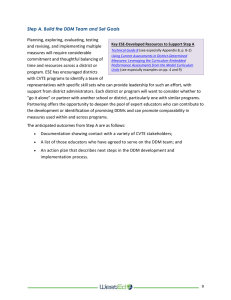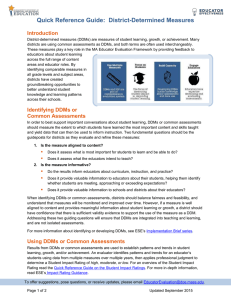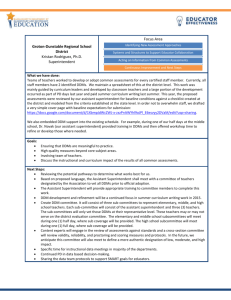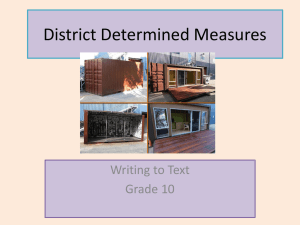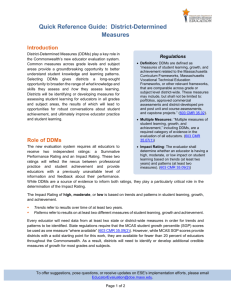District-Determined Measures
advertisement
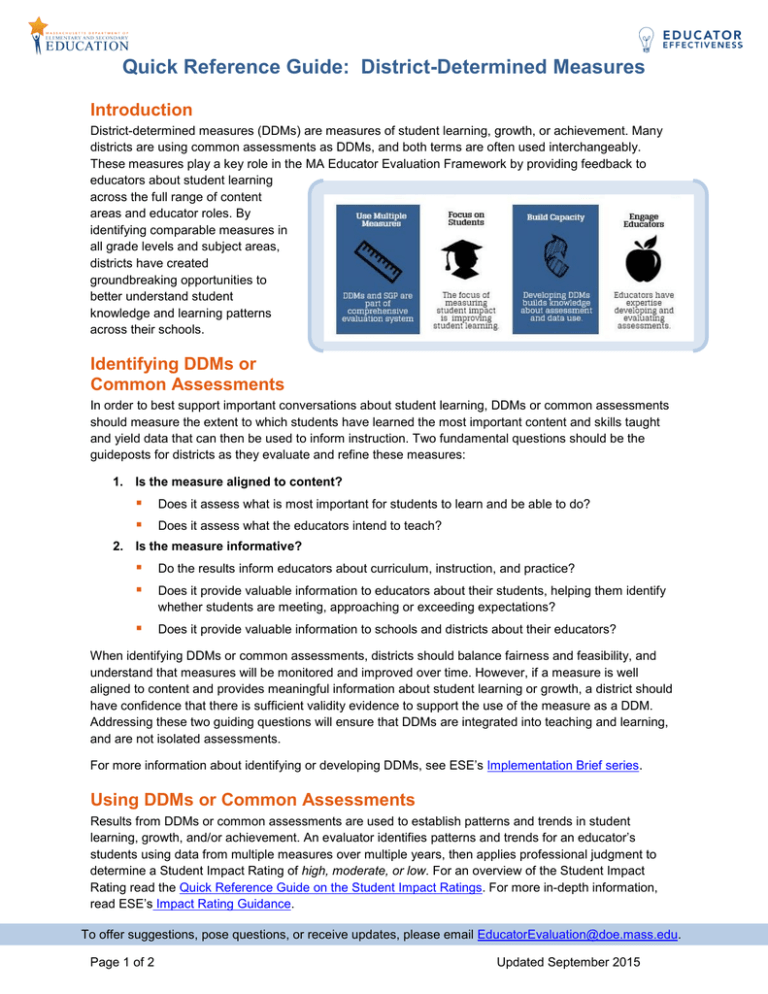
Quick Reference Guide: District-Determined Measures Introduction District-determined measures (DDMs) are measures of student learning, growth, or achievement. Many districts are using common assessments as DDMs, and both terms are often used interchangeably. These measures play a key role in the MA Educator Evaluation Framework by providing feedback to educators about student learning across the full range of content areas and educator roles. By identifying comparable measures in all grade levels and subject areas, districts have created groundbreaking opportunities to better understand student knowledge and learning patterns across their schools. Identifying DDMs or Common Assessments In order to best support important conversations about student learning, DDMs or common assessments should measure the extent to which students have learned the most important content and skills taught and yield data that can then be used to inform instruction. Two fundamental questions should be the guideposts for districts as they evaluate and refine these measures: 1. Is the measure aligned to content? Does it assess what is most important for students to learn and be able to do? Does it assess what the educators intend to teach? 2. Is the measure informative? Do the results inform educators about curriculum, instruction, and practice? Does it provide valuable information to schools and districts about their educators? Does it provide valuable information to educators about their students, helping them identify whether students are meeting, approaching or exceeding expectations? When identifying DDMs or common assessments, districts should balance fairness and feasibility, and understand that measures will be monitored and improved over time. However, if a measure is well aligned to content and provides meaningful information about student learning or growth, a district should have confidence that there is sufficient validity evidence to support the use of the measure as a DDM. Addressing these two guiding questions will ensure that DDMs are integrated into teaching and learning, and are not isolated assessments. For more information about identifying or developing DDMs, see ESE’s Implementation Brief series. Using DDMs or Common Assessments Results from DDMs or common assessments are used to establish patterns and trends in student learning, growth, and/or achievement. An evaluator identifies patterns and trends for an educator’s students using data from multiple measures over multiple years, then applies professional judgment to determine a Student Impact Rating of high, moderate, or low. For an overview of the Student Impact Rating read the Quick Reference Guide on the Student Impact Ratings. For more in-depth information, read ESE’s Impact Rating Guidance. To offer suggestions, pose questions, or receive updates, please email EducatorEvaluation@doe.mass.edu. Page 1 of 2 Updated September 2015 Quick Reference Guide: District-Determined Measures District Planning Activities Districts should actively engage educators in the process of identifying, implementing, and revising DDMs or common assessments that will be used to inform the Student Impact Rating. The following list includes critical steps districts should consider and links to available ESE resources: As educators continue to build and refine assessments, they should remember to measure what is most important, instead of placing importance on what can be easily measured. Identify a team of administrators, teachers and specialists to focus and plan the district’s ongoing DDMs work. Complete an inventory of existing measures used in the district’s schools and assess where there are strengths to build on and gaps to fill. This includes looking at measures for administrators, specialized instructional support personnel, and CVTE educators, where appropriate. Select measures that are well aligned to the critical content students are learning and meaningful to educators. Where applicable, identify an appropriate approach to measuring growth. Determine consistent protocols for when, where, and how measures will be administered Set the parameters for what level of growth represents high, moderate, or low growth. Identify approach for administering, scoring, and managing data associated with DDMs or common assessments. Review measures to ensure they are appropriate and fair for all students, including ELL students and students with disabilities. Create a process of continuous review of assessments to ensure that DDMs are providing meaningful feedback regarding student learning. Regulations • Definition: DDMs are defined as “measures of student learning, growth, and achievement related to the Massachusetts Curriculum Frameworks, Massachusetts Vocational Technical Education Frameworks, or other relevant frameworks, that are comparable across grade or subject level districtwide. These measures may include, but shall not be limited to: portfolios, approved commercial assessments and district-developed pre and post unit and course assessments, and capstone projects.” (603 CMR 35.02). Learn More About DDMs: DDMs and Student Impact Rating Implementation Brief Series Developing Common Measures Webpage Rating Educator Impact: The Student Impact Rating • Multiple Measures: “Multiple measures of student learning, growth, and achievement,” including DDMs, are a required category of evidence in the evaluation of all educators. (603 CMR 35.07(1)) Student Impact Rating Webpage Part VII of ESE’s Model System for Educator Evaluation • Impact Rating: The evaluator shall determine whether an educator is having a high, moderate, or low impact on student learning based on trends (at least two years) and patterns (at least two measures). (603 CMR 35.09(2)) Commissioner’s August 15, 2013 Memorandum re: Implementation Timelines To offer suggestions, pose questions, or receive updates, please email EducatorEvaluation@doe.mass.edu. Page 2 of 2 Updated September 2015
